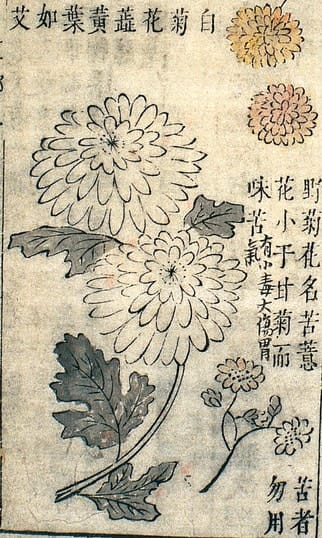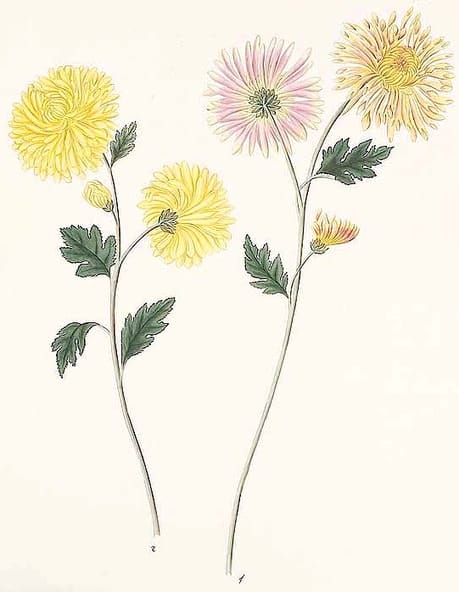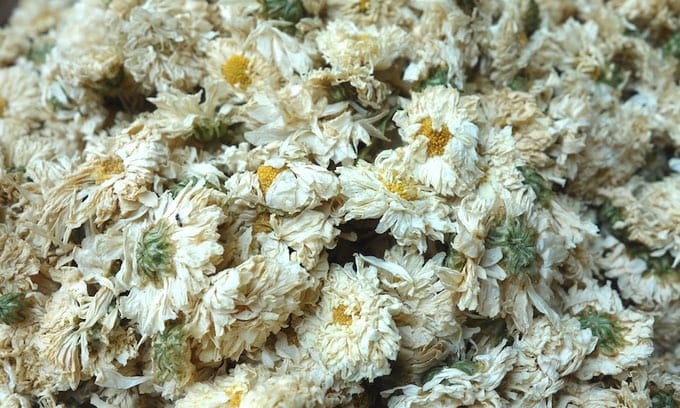Chrysanthemum, Ju Hua 菊花
Ju Hua (TCM) Ben Cao Yuan Shi, 1612 (Welcome)
Ben Cao Yuan Shi, 1612 (Welcome) Hortus sempervirens, Kerner, 1824
Hortus sempervirens, Kerner, 1824 Chrysanthemum flower (Adam, 2016)
Chrysanthemum flower (Adam, 2016)Botanical name:
Chrysanthemum morifolium (syn. C. sinense, C. horotrum, Anthemis artemisifolia A. grandiflora, A. stipulacea)
Yellow and White flowered Chrysanthemum flowers are used. The white is sweeter and better to calm the Liver and clear the Eyes. The yellow is more bitter, better to clear Wind-Heat and Liver-Heat. In practice, they are both used similarly.
Parts used:
Flower
Temperature & Taste:
Cool, dry. Sweet, Bitter (younger buds are sweeter, older buds are more bitter)
Classifications:
A. Clear Exterior Wind-Heat
Uses:
1. Clears Wind-Heat, Promotes Sweat:
-Fever, Headache in cold or Flu
-a good cooling drink to be taken in hot weather and hot constitutions
2. Clears Liver Heat, Clears the Eyes:
-red, swollen, itchy, dry or painful eyes from acute wind-heat or Liver heat
-floaters, blurry vision, dizziness
-a good tea for people with Liver Heat
3. Calms Liver, Stops Wind:
-headache, dizziness, tinnitus
-childhood convulsions
4. Resists Poison:
-toxic Sores and Swellings
Dose:
Decoction: 3–9 grams
Infusion; a teaspoonful can be added to a cup as an infusion, often combined with Goji berry (Gou Qi Zi)
Comment:
1. Ye Ju Hua is the Indian Chrysanthemum, Chrysanthem indicum. It has similar properties, but is more bitter and stronger to clear Heat and Poison. C. morifolium is accounted better for the Liver and Eyes.
2. One of the Chinese names for Camomile is Xi Jua Hua, ‘Western Chrysanthemum’. This shows the close relationship and similar functions these medicines possess.
Main Combinations:
Chrysanthemum Ju Hua is regularly combined with Lycium Gou Qi (Goji). These 2 are regularly combined together as a tea to be drunk freely throughout the day, as well as being combined in various formula. Chrysanthemum clears Liver heat and toxin while Goji fruit nourish Blood and Yin. Both herbs are beneficial for the eyes and eyesight. Together, they are also very good for the skin and complexion for which they are often drunk by Chinese women.
1. Wind-Heat Cold or beginning of Fever:
i. Fever, Chills, Headache, Sore Eyes, Itchy Throat, Chrysanthemum Ju Hua with Peppermint (Bo He)
ii. Chrysanthemum Ju Hua with Mulberry leaf (Sang Ye), Forsythia Lian Qiao, Peppermint (Bo He), Schizonepeta Jing Jie (as in San Ju Yin from Wen Bing Tiao Bian [Systemic Discourse on Warm Diseases])
2. Acute Headache from Wind-Heat, Chrysanthemum Ju Hua with Ligusticum Chuan Xiong.
3. Sore, Red Eyes, Blurry Vision:
i. Chrysanthemum Ju Hua with Lycium Gou Qi Zi (Goji berries)
ii. in chronic cases, or in the aged (those with Kidney weakness), Chrysanthemum Ju Hua with Lycium Gou Qi Zi (Goji berries) are combined with Liu Wei Di Huang Wan (Rehmannia 6) to make Qi Ju Di Huang Wan.
4. Liver Heat and Wind type Headache or Dizziness:
i. Chrysanthemum Ju Hua with Peony (Bai Shao), Mistletoe (Sang Ji Sheng), Gastrodia Tian Ma
ii. Chrysanthemum Ju Hua with Peony (Bai Shao), Mulberry leaf (Sang Ye), Uncaria Gou Teng.
5. Hypertension, High Cholesterol:
i. Chrysanthemum Ju Hua with Hawthorn fruit (Shan Zha)
ii. Chrysanthemum Ju Hua with Cassia Jue Ming Zi, Self Heal (Xia Ku Cao)
Major Formulas:
Gou Teng San
Ling Jiao Gou Teng Tang
Qi Ju Di Huang Wan
Sang Ju Yin
Long Dan Bi Yuan Fang
Cautions:
Generally Safe.
1. Avoid full doses with Coldness of the Stomach and Diarrhea
2. Traditionally it is said that Coptis Huang Lian and Platycladus Bai Zi Ren ‘antagonize’ Chrysanthemum Ju Hua, meaning they are not compatible.
